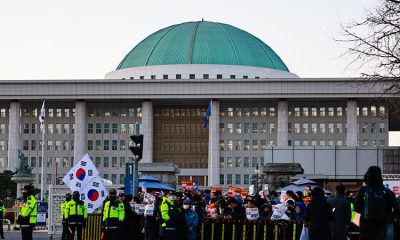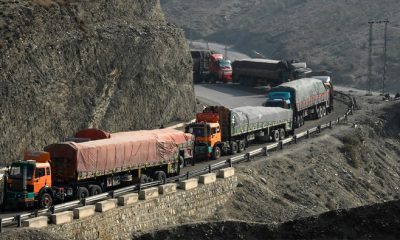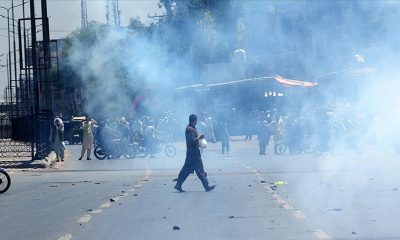Pakistan faces a political flash point after police have charged the country’s former Prime Minster Imran Khan under anti-terror laws. Khan is looking and making efforts day and night to make possible his return as he allegedly accused the US and the Pakistan army for removing him from office in a “dawn” conspiracy. He was ousted in April following a vote of no confidence over allegations of economic mismanagement and mishandling of the country’s foreign policy.
Apparently, rising prices of food, the country’s debt and the loss of military support have only worsened under the current government led by PM Shehbaz Sharif, and people are turning back to Khan. In July, residents of Punjab, Pakistan’s most populous state had given Khan’s party Tehreek-e-Insafa, a landmark victory in local elections.
During the time of elections, Khan said that “our camps are full of voters while opposition camps are empty.”
However, Khan is in big trouble now. He has so many inquiries to succeed. Khan, a cricketer-turned-politician, has been charged with “terrorizing and threatening” police officers and a female judge at a rally in the capital city Islamabad.
Khan said he “will not remain silent” and will sue the officials, referring to the police chief and judge involved in the case against Shahbaz Gill, his close aide and chief of staff. Gill, who faces sedition charges for inciting mutiny in the military, has allegedly been tortured in police custody.
Khan’s speech also prompted the country’s media watchdog to ban television channels from broadcasting his live addresses and also blocked Mr. Khan’s YouTube channel, a move Khan said will be challenged in court.
Khan in a tweet said, “Imported government blocked YouTube midway through my speech. This just shows the desperation of those who for their self interest are willing to push Pakistan towards political and economic chaos.”
It is no easy to arrest Khan
Things turned worse and fragile when Interior Minister Rana Sanaullah said the government was mulling over the ex-premier Khan’s arrest, yet another big trouble for Khan but a job for the police as Khan’s supporters will not allow them to take him away so simply.
Khan himself did not immediately comment, but his hundreds of supporters surrounded his home to potentially stop police from reaching him. Khan is now secured transit bail till August 25 after he filed a pre-arrest bail application in the Islamabad High Court earlier to avoid arrest in a terror case filed against him.
Political, economic and social crisis
“I believe that confrontation between Imran Khan and Prime Minister Shahbaz Sharif led to coalition partners touching its peak. Registration of cases/FIR’s between the two sides now plunging the country into a civil war like situation,” Shamim Shaid, a Pakistan political expert told Harici.
Shaid said that Pakistan is ahead with multiple issues like economic crisis, growing violence and terrorism in the region, Taliban empowering in its close neighbor Afghanistan, banned TTP’s (Pakistani Taliban) demands for declaring Tribal districts as free zones, economic crisis and rising rate of poverty and unemployment.
“Pakistan is also ahead with another serious issue of debts, which is now over six hundred billion dollars. The IMF also slaps more conditions on Pakistan by passing each day – and almost Balochistan and Sindh are ahead with flood havoc. In the light of the existing internal and internal crisis Pakistan couldn’t afford political confrontation,” Shaid added.
Pakistan has been going through a political instability, and this is the matter of concern.
Accusations against Khan
“There is an open fight going on between Khan’s party, Tehreek-e-Insafa, and the federal government under Sharif’s administration, and the anti-terrorism charges related to Khan is considered one of the biggest charges in Pakistan,” Rasheed Safi, an Islamabad-based political commentator and columnists told Harici.
Safi said that the current terrorism charges, and the recent report accusing Khan’s party of receiving funds from abroad, which is illegal in Pakistan, has obviously created a new tension for Imran Khan to deal with.
Besides that, Safi said that the Pakistan Federal Investigation Agency has also launched an inquiry against Khan and his party for selling a gifted necklace. Investigation agency (FIA) claimed that Imran Khan had purchased state gifts such as cufflinks, a watch, ring and other valuables at Rs20m and sold them for Rs180m instead of depositing it to the state gift repository.
These are the three big allegations against Imran Khan and to his political party which could have proved a deterrent for him.
“If we look from the perspective of law, Imran Khan and some of key figures in Tehreek-e-Insafa are under immense pressure at the moment. The arrest of Imran Khan after 25 August is also not out of the ordinary,” Safi added.
But the arrest of Khan is not an easy task, Safi said that the government institutions in Pakistan are weak and the officials also fear implication.
Pakistan could anytime lead to a full military rule
But in a bigger picture, Pakistan could anytime lead to a full military rule in the midst of a major political and constitutional crisis, with Khan’s supporters already warned to take over Pakistan if police tried to arrest him.
It is fear that who will stop the public, a population of 220 million people if the political party strays from the path of law and constitution.
Ali Amin Khan Gandapur, Former Federal Minister for Kashmir Affairs and Minister for Revenue and Estate Khyber Pakhtunkhwa (KP), said that if Khan is arrested they will take over Islamabad by the power of people, and called on police to stop being part of this political war anymore.
Khan’s supporters taking social media platforms said that the police must first run over them before they can reach Khan.
The Pakistani military establishment is aware of the fact that Khan can still hold mass protests, and could draw millions out to the street, not good at all for a nuclear-armed nation amid an economic crisis, exacerbated by rising global food prices due to the Russia-Ukraine war.

 AMERICA1 week ago
AMERICA1 week ago
 AMERICA2 weeks ago
AMERICA2 weeks ago
 EUROPE1 week ago
EUROPE1 week ago
 AMERICA2 weeks ago
AMERICA2 weeks ago
 OPINION1 week ago
OPINION1 week ago
 AMERICA1 week ago
AMERICA1 week ago
 MIDDLE EAST1 week ago
MIDDLE EAST1 week ago
 OPINION2 weeks ago
OPINION2 weeks ago





















